Thermal Anemometry Grid Sensor
Abstract
:1. Introduction
2. Grid Sensor Technique
3. A Brief Review of the Principles of Thermal Anemometry
4. Thermal Anemometry Grid Sensor (TAGS)
4.1. General Sensor Design and Applicable Operation Modes
4.2. Analysis of the Applicable Operation Modes
4.3. Electronic Circuit
4.4. Operation Cycle
- 1.
- First, was applied sequentially to the transmitters, and the fluid temperatures were determined via a temperature calibration curve from the measured currents.
- 2a.
- Next, for the constant voltage anemometry (CVA) mode, the overheat temperatures of the resistors in the equilibrium were of interest. Therefore, the voltage was simultaneously applied to all transmitters to heat the resistors. Subsequently, was applied sequentially to the transmitters to measure the temperatures in the overheated state (Figure 6). It was ensured that cooling of the resistors during this unheated phase with was not too extensive. For the sensor reported in this paper, we targeted a temperature decrease smaller than .
- 2b.
- For the alternative thermal transient anemometry (TTA) mode, the resistors were heated simultaneously by application of to all transmitters. After a sufficient heating time, but not necessarily up to equilibrium temperature, the heating voltage was switched off and the time constant of the temperature drop during the cooling period was measured by the sequential application of to the transmitters. The ratio of the durations between the heated and the unheated phase as well as the resulting sampling time is dependent on the thermal relaxation time of the resistors.
5. Sensor Test and Characterization
5.1. Experimental Setup
5.2. Modelling of the Sensor´s Heat Balance
5.3. Comparison of Experimental Results and Modelling
6. Conclusions
Acknowledgments
Author Contributions
Conflicts of Interest
References
- Hassan, Y.A.; Blanchat, T.K.; Seeley, C.H. PIV flow visualisation using particle tracking techniques. Meas. Sci. Technol. 1992, 3, 633–642. [Google Scholar] [CrossRef]
- Krauss, T.; Meyer, L. Characteristics of turbulent velocity and temperature in a wall channel of a heated rod bundle. Exp. Therm. Fluid Sci. 1996, 12, 75–86. [Google Scholar] [CrossRef]
- Hampel, U. Anordnung zur Zweidimensionalen Messung des Geschwindigkeitsfeldes in Strömungen. Patent No. DE102007019927, 25 September 2008. [Google Scholar]
- Prasser, H.-M.; Böttger, A.; Zschau, J. A new electrode-mesh tomograph for gas-liquid flows. Flow Meas. Instrum. 1998, 9, 111–119. [Google Scholar] [CrossRef]
- Silva, M.J.D.; Schleicher, E.; Hampel, U. Capacitance wire-mesh sensor for fast measurement of phase fraction distributions. Meas. Sci. Technol. 2007, 18, 2245–2251. [Google Scholar] [CrossRef]
- Schäfer, T.; Schubert, M.; Hampel, U. Temperature Grid Sensor for the Measurement of Spatial Temperature Distributions at Object Surfaces. Sensors 2013, 13, 1593–1602. [Google Scholar] [CrossRef] [PubMed]
- Ritterath, M.; Öztürk, O.C.; Prasser, H.M. Thermo-resistive mesh sensors (TMS) for temperature field measurements. Flow Meas. Instrum. 2011, 22, 343–349. [Google Scholar] [CrossRef]
- Bruun, H.H. Hot Wire Anemometry: Principles and Signal Analysis; Oxford University Press: Oxford, UK, 1996. [Google Scholar]
- Collis, D.C.; Williams, M.J. Two-dimensional convection from heated wires at low Reynolds numbers. J. Fluid Mech. 1959, 6, 357–384. [Google Scholar] [CrossRef]
- Kramers, H. Heat transfer from spheres to flowing media. Physica 1946, 12, 61–80. [Google Scholar] [CrossRef]
- King, L. On the convection of heat from small cylinders in a stream of fluid: Determination of the convection constants of small platinum wires with applications to hot-wire anemometry. Philos. Trans. R. Soc. 1914, 214, 373–432. [Google Scholar] [CrossRef]
- Sarma, G.R. Analysis of a constant voltage anemometer circuit. In Proceedings of the 1993 IEEE Instrumentation and Measurement Technology Conference, Irvine, CA, USA, 18–20 May 1993. [Google Scholar]
- Foss, J.F.; Schwannecke, J.K.; Lawrenz, A.R.; Mets, M.W.; Treat, S.C.; Dusel, M.D. The thermal transient anemometer. Meas. Sci. Technol. 2004, 15, 2248–2255. [Google Scholar] [CrossRef]
- Sigloch, H. Technische Fluidmechanik; Springer: Berlin, Germany, 2005. [Google Scholar]
- Churchill, S.W. A comprehensive correlating equation for laminar, assisting, forced and free convection. AIChE J. 1977, 23, 10–16. [Google Scholar] [CrossRef]
- Churchill, S.W.; Chu, H.H.S. Correlating equations for laminar and turbulent free convection from a vertical plate. Int. J. Heat Mass Transf. 1975, 18, 1323–1329. [Google Scholar] [CrossRef]
- Gampert, B. Grenzschichttheoretische Probleme des aerodynamischen Schmelzspinnprozesses. Ph.D. Thesis, Technical University of Berlin, Berlin, Germany, 1973. [Google Scholar]
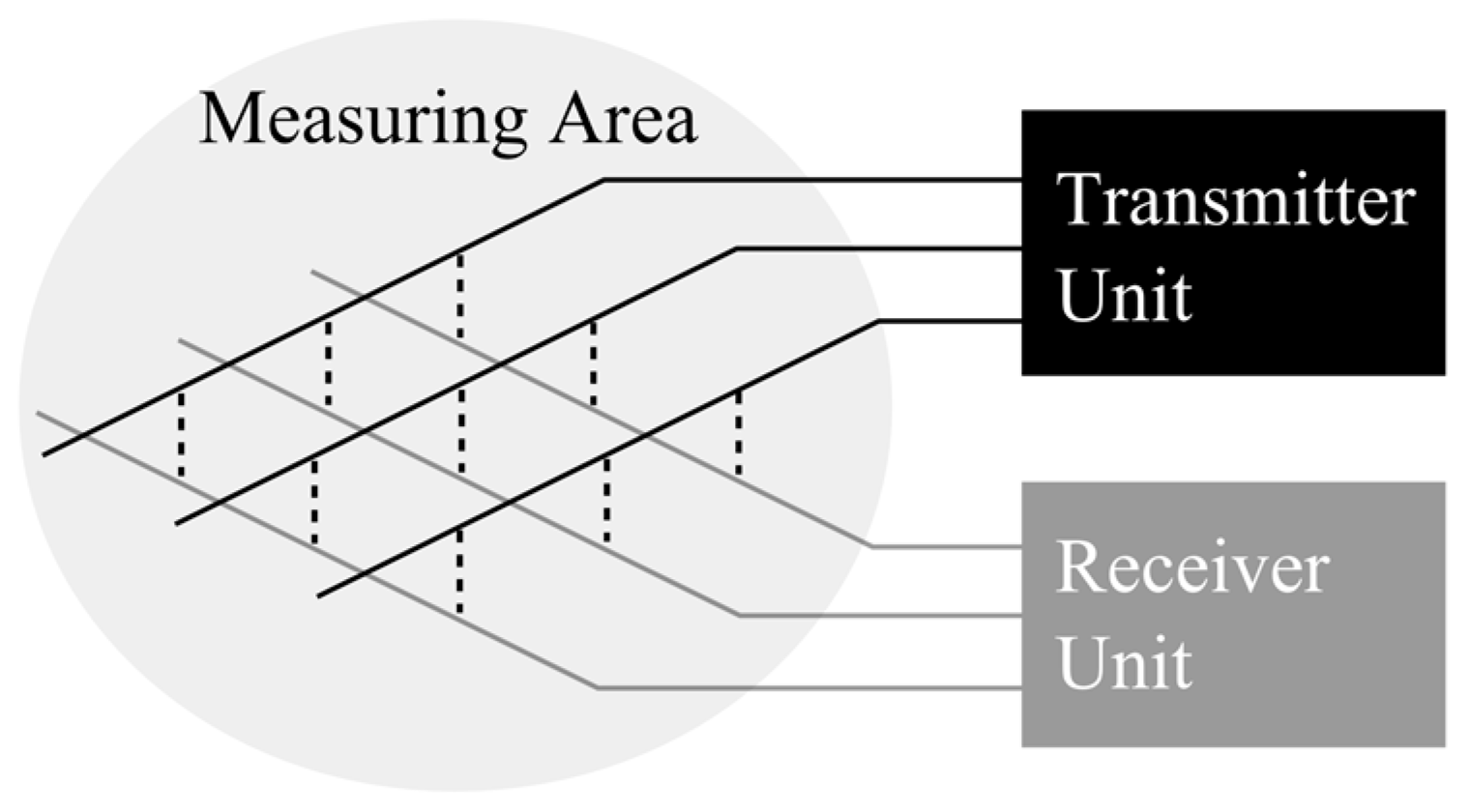
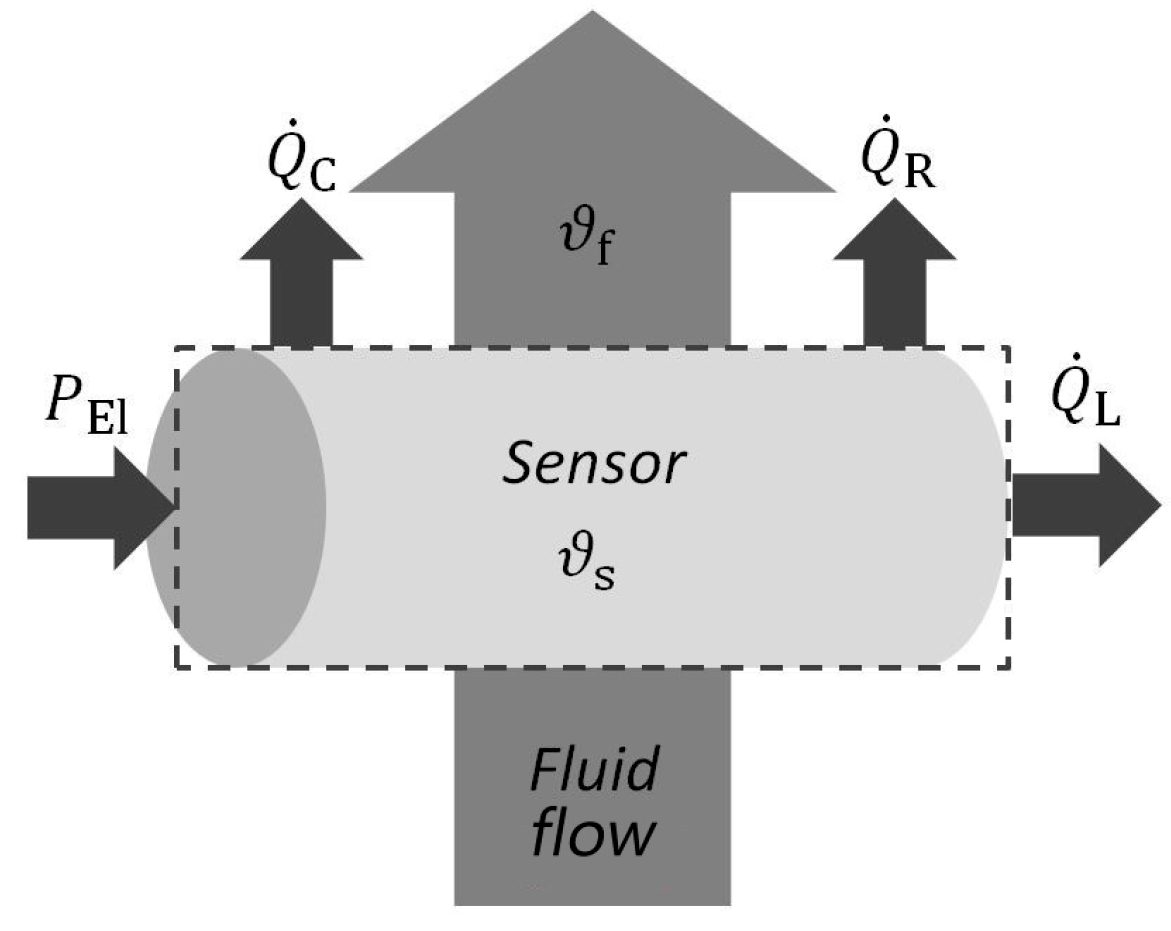
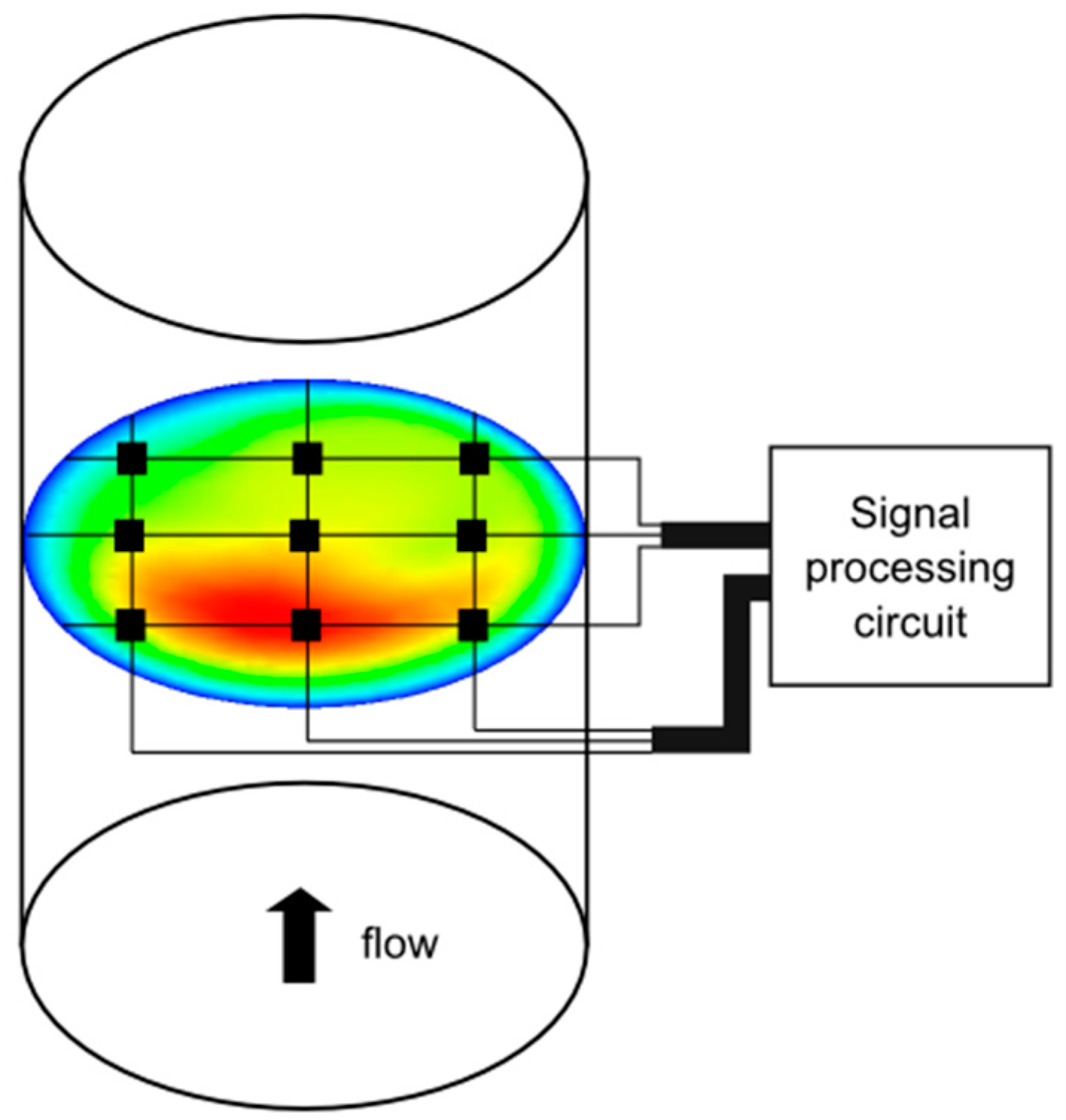
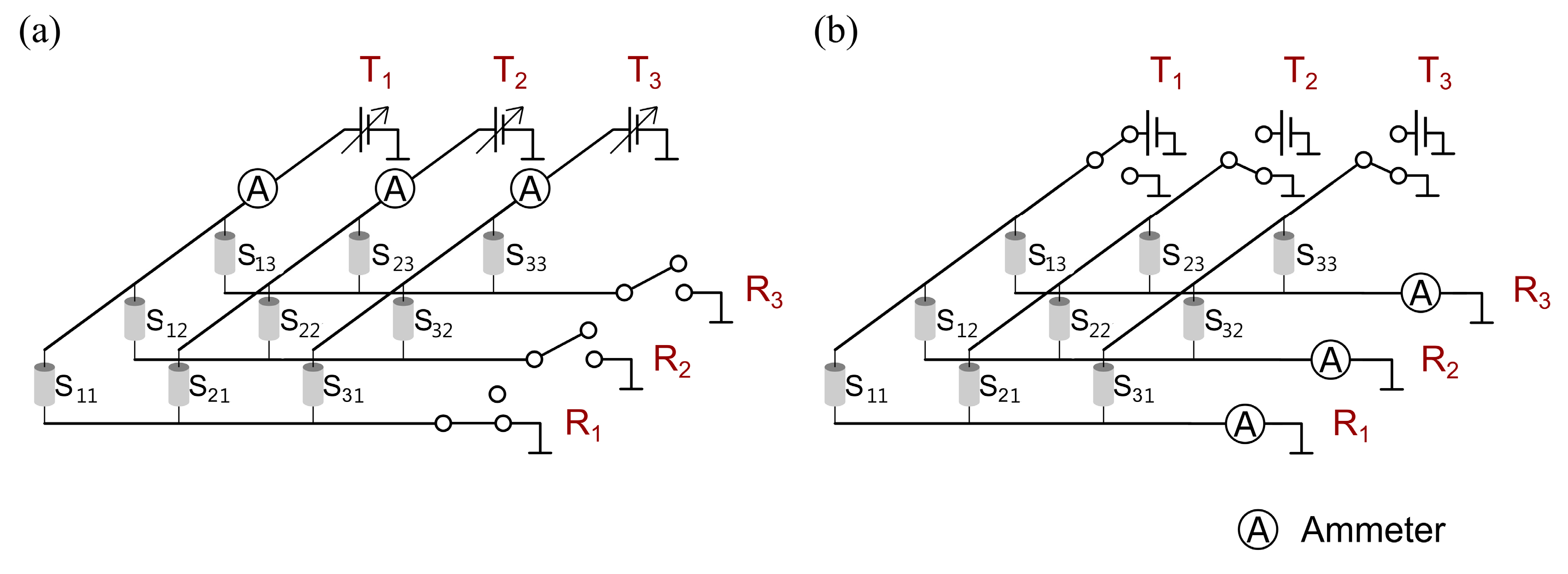
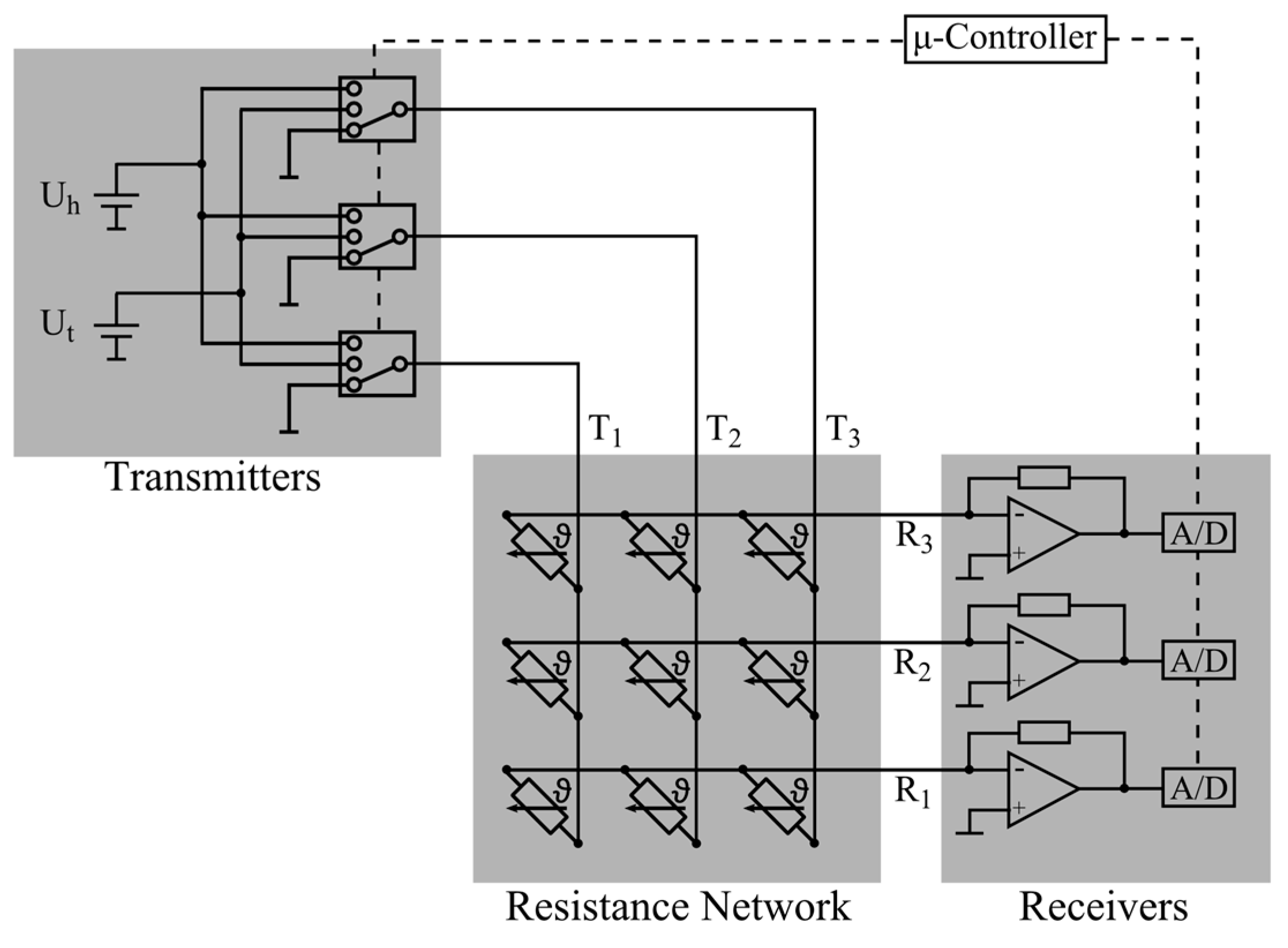


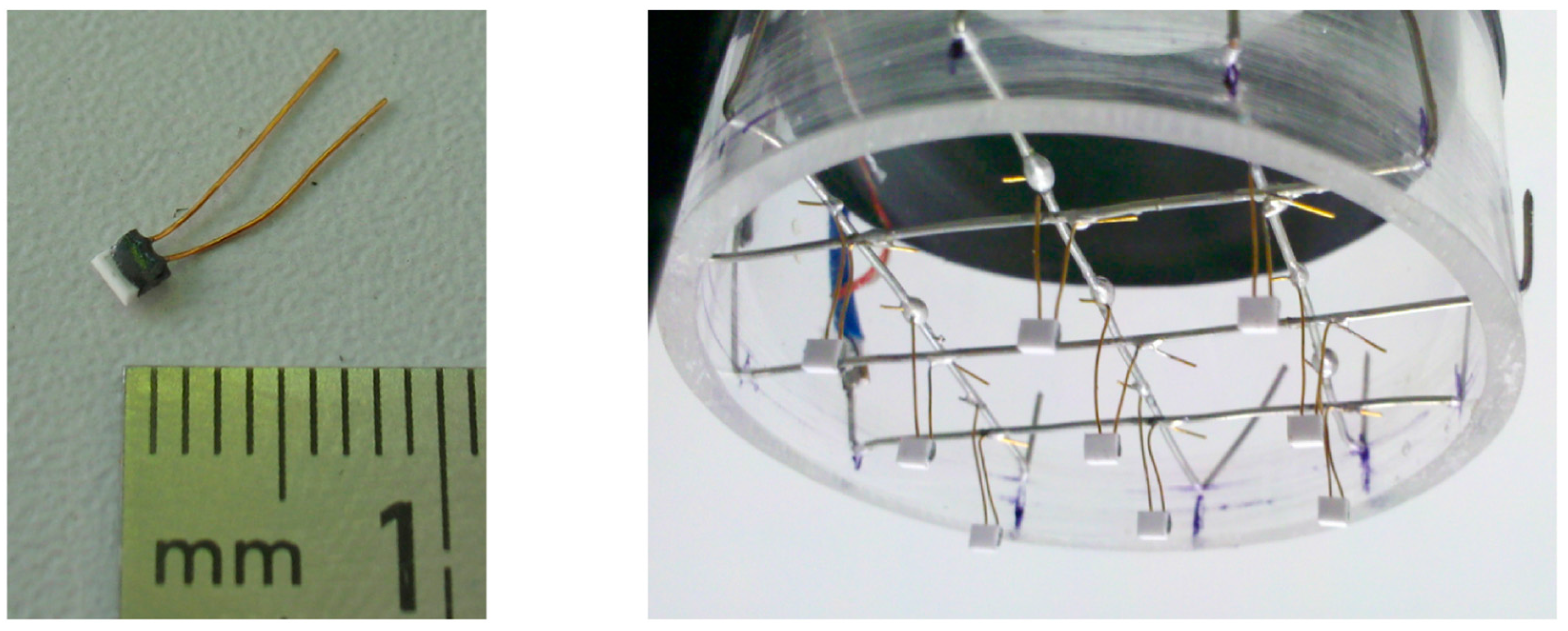
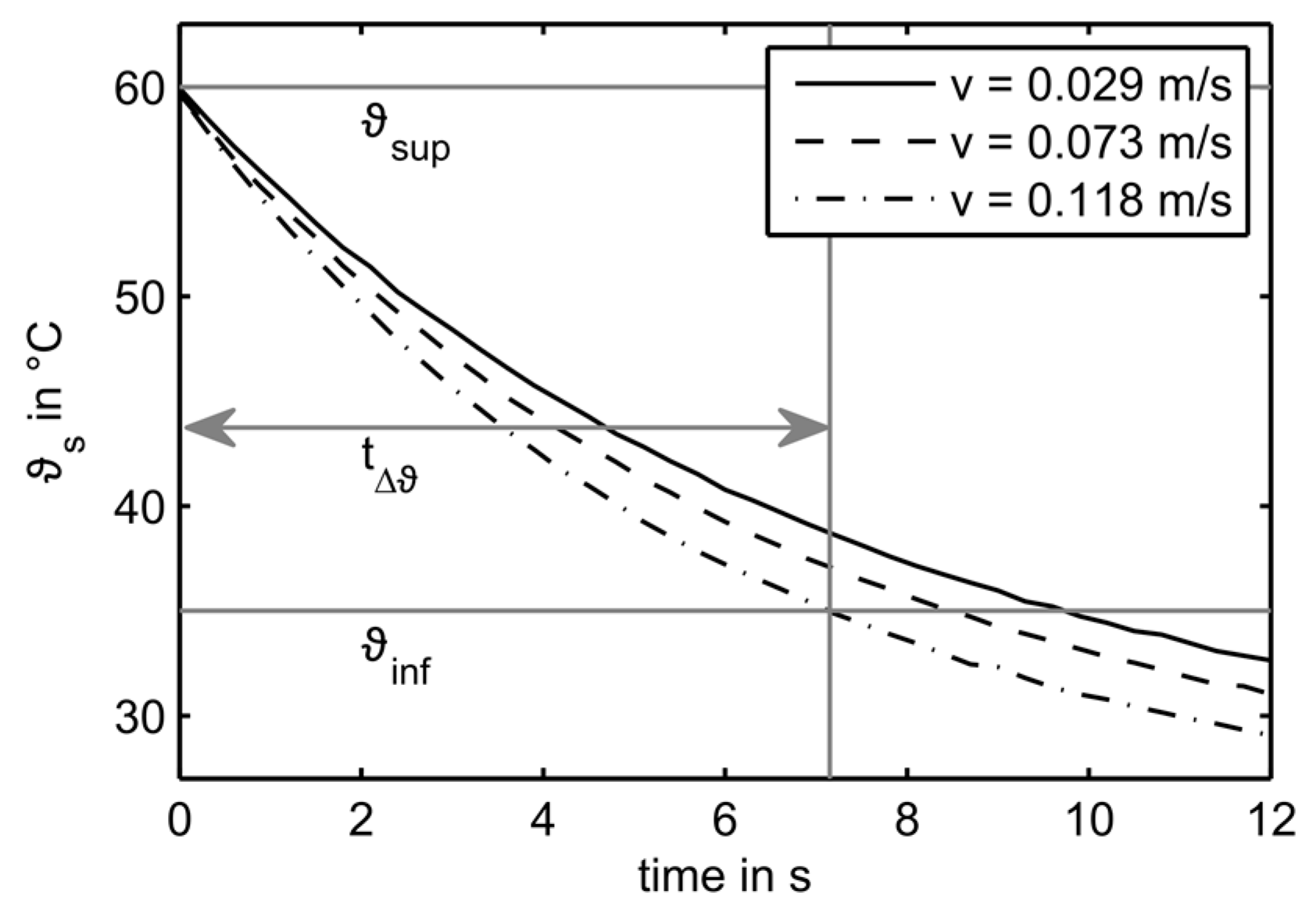


| Anemometry Operation Mode | Abbreviation | Characteristic Variable |
|---|---|---|
| Constant Temperature | CTA | |
| Constant Current | CCA | |
| Constant Voltage | CVA | |
| Thermal Transient | TTA |
| Scheme | Number of Active Transmitters | Side of Current Measurement | Number of Simultaneous Scanning Points | ||||
|---|---|---|---|---|---|---|---|
| CTA | CCA | CVA | TTA | ||||
| 1 | 3 | Transmitter | 3 | 3 | 3 | 3 | 3 |
| 2 | 1 | Receiver | 3 | 1 | 1 | 3 | 3 |
| Scheme | Nr. | ||||||
|---|---|---|---|---|---|---|---|
| V | mA | Ω | mA | Ω | |||
| 1 | S11 | 2.1 | 15.61 | 134.5 | 17.50 | 120.0 | 10.8% |
| S21 | 2.2 | 18.33 | 120.0 | 18.33 | 120.0 | 0.0% | |
| S31 | 2.3 | 21.05 | 109.3 | 19.16 | 120.0 | −9.9% | |
| 2 | S11 | 2.2 | 17.78 | 123.7 | 17.82 | 123.5 | 0.2% |
| S12 | 0 | 18.25 | 120.5 | 18.82 | 120.4 | 0.2% | |
| S13 | 0 | 18.70 | 117.6 | 18.73 | 117.5 | 0.2% |
| Parameter | Value | Uncertainty | |
|---|---|---|---|
| 2.80 V | 0.01 V | 4.0% | |
| 6.0 mm | 0.1 mm | 2.5% | |
| 7.9 mm | 0.1 mm | 1.5% | |
| 40.0 K | 0.3 K | −4.6% |
© 2017 by the authors. Licensee MDPI, Basel, Switzerland. This article is an open access article distributed under the terms and conditions of the Creative Commons Attribution (CC BY) license (http://creativecommons.org/licenses/by/4.0/).
Share and Cite
Arlit, M.; Schleicher, E.; Hampel, U. Thermal Anemometry Grid Sensor. Sensors 2017, 17, 1663. https://doi.org/10.3390/s17071663
Arlit M, Schleicher E, Hampel U. Thermal Anemometry Grid Sensor. Sensors. 2017; 17(7):1663. https://doi.org/10.3390/s17071663
Chicago/Turabian StyleArlit, Martin, Eckhard Schleicher, and Uwe Hampel. 2017. "Thermal Anemometry Grid Sensor" Sensors 17, no. 7: 1663. https://doi.org/10.3390/s17071663
APA StyleArlit, M., Schleicher, E., & Hampel, U. (2017). Thermal Anemometry Grid Sensor. Sensors, 17(7), 1663. https://doi.org/10.3390/s17071663




